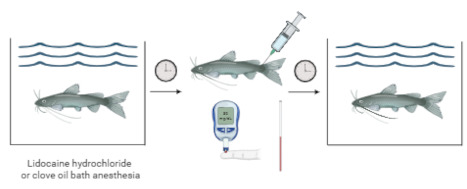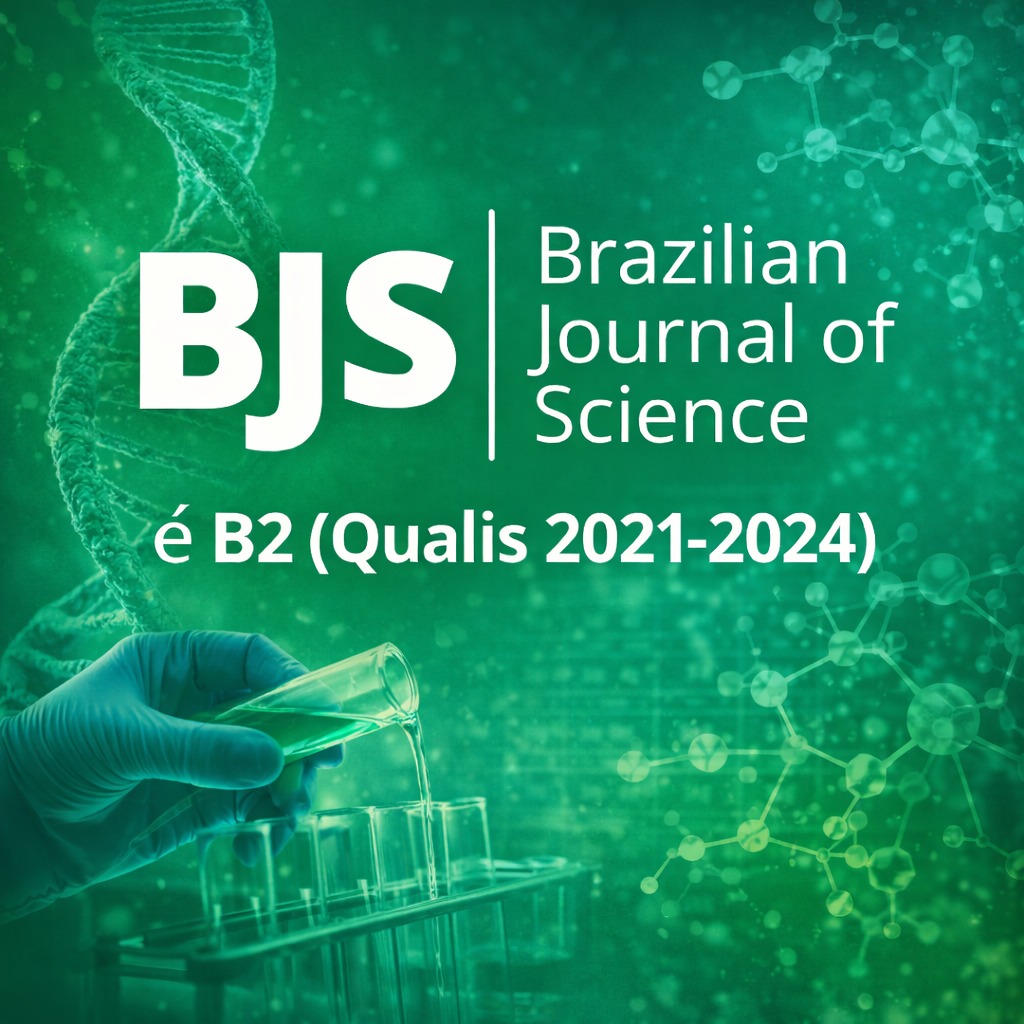Physiological responses of jundiá Rhamdia quelen juveniles anesthetized with different concentrations of lidocaine hydrochloride (Lidostesim® 3%)
DOI:
https://doi.org/10.14295/bjs.v3i3.541Keywords:
local anesthetic, glucose level, recovery time, Pimelodidae, stressAbstract
The aim of this trial was to determine the effect of lidocaine hydrochloride-based immersion anesthesia in concentrations of 1,000, 1,500, 2,000 and 2,500 mg L-1 on physiological responses of jundiá Rhamdia quelen, with the control group anesthetized with clove oil (50 mg L-1) bath anesthesia. Ten jundiá juveniles were used in each experimental and control groups in order to analyze the hematocrit, blood glucose levels and induction and recovery times. Jundiás anesthetized in 2,000 and 2,500 mg L-1 solutions showed percentual hematocrit increase (42.7 ± 0.9% and 43.7 ± 0.7 %, P < 0.05). It was observed inverse association between blood glucose levels and lidocaine concentration, with values ranging from 57.3 ± 14.7 mg dL-1 to jundiá anesthetized in 1,000 mg L-1 and 39.5 ± 12.5 mg dL-1 in 2,500 mg L-1 anesthetic baths, with higher values detected in the control group (78.1 ± 12.5 mg dL-1, P < 0.001). Likewise, it was observed inverse relationship between lidocaine hydrochloride concentration and induction times, but direct association with recovery times. Higher concentrations were the most effective as blood glucose reduction and maintenance of hematocrit levels, with promising induction and recovery times for future anesthetic trials.
References
Abbas, H. H. H., Abdel-Gawad, A. S., & Akkr, A. A. (2006). Toxicity and efficacy of lidocaine as an anesthetic for Nile tilapia; Oreochromis niloticus. Pakistan Journal of Biological Sciences, 9(12), 2236-2242. https://scialert.net/abstract/?doi=pjbs.2006.2236.2242 DOI: https://doi.org/10.3923/pjbs.2006.2236.2242
Anderson, D. E., & Edmondson, M. A. (2013). Prevention and management of surgical pain in cattle. Veterinary Clinics: Food Animal Practice, 29(1), 157-184. https://doi.org/10.1016/j.cvfa.2012.11.006 DOI: https://doi.org/10.1016/j.cvfa.2012.11.006
Barbas, L. A. L., Torres, M. F., da Costa, B. M. P., Feitosa, M. J. M., Maltez, L. C., Amado, L. L., ... & Hamoy, M. (2021). Eugenol induces body immobilization yet evoking an increased neuronal excitability in fish during short-term baths. Aquatic Toxicology, 231, 105734. https://doi.org/10.1016/j.aquatox.2020.105734 DOI: https://doi.org/10.1016/j.aquatox.2020.105734
Borges, A., Scotti, L. V., Siqueira, D. R., Jurinitz, D. F., & Wassermann, G. F. (2004). Hematologic and serum biochemical values for jundiá (Rhamdia quelen). Fish Physiology and Biochemistry, 30, 21-25. https://doi.org/10.1007/s10695-004-5000-1 DOI: https://doi.org/10.1007/s10695-004-5000-1
Carneiro, P. C. F., & Mikos, J. D. (2005). Freqüência alimentar e crescimento de alevinos de jundiá, Rhamdia quelen. Ciência Rural, 35, 187-191. https://doi.org/10.1590/S0103-84782005000100030 DOI: https://doi.org/10.1590/S0103-84782005000100030
Carrasco, S., Sumano, H., & Navarro-Fierro, R. (1984). The use of lidocaine-sodium bicarbonate as anaesthetic in fish. Aquaculture, 41(4), 395-398. https://doi.org/10.1016/0044-8486(84)90207-2 DOI: https://doi.org/10.1016/0044-8486(84)90207-2
Chen, N. H. (2012). Comparison of clinical hematological changes under anesthetization in Crucian carp (Carassius auratus auratus) following treatment with local anesthetics. African Journal of Biotechnology, 11(22), 6149-6142. https://www.ajol.info/index.php/ajb/article/view/101771 DOI: https://doi.org/10.5897/AJB11.1639
Collymore, C., Tolwani, A., Lieggi, C., & Rasmussen, S. (2014). Efficacy and safety of 5 anesthetics in adult zebrafish (Danio rerio). Journal of the American Association for Laboratory Animal Science, 53(2), 198-203. https://www.ingentaconnect.com/content/aalas/jaalas/2014/00000053/00000002/art00012#
Conrado, A. L., Neyrão, I. M., Iunes, R. S., Bruno, C. E., & Lopes, P. R. (2019). Microscopy and classification of barbels of silver catfish Rhamdia quelen, Siluriformes, Pimelodidae. Investigação, 18, 50-55. https://publicacoes.unifran.br/index.php/investigacao/article/view/3288
Crosby, T. C., Petty, B. D., Hamlin, H. J., Guillette Jr, L. J., Hill, J. E., Hartman, K. H., & Yanong, R. P. (2010). Plasma cortisol, blood glucose, and marketability of koi transported with metomidate hydrochloride. North American Journal of Aquaculture, 72(2), 141-149. https://doi.org/10.1577/A09-023.1 DOI: https://doi.org/10.1577/A09-023.1
Cunha, M. A. D., Zeppenfeld, C. C., Garcia, L. D. O., Loro, V. L., Fonseca, M. B. D., Emanuelli, T., ... & Baldisserotto, B. (2010). Anesthesia of silver catfish with eugenol: time of induction, cortisol response and sensory analysis of fillet. Ciência Rural, 40, 2107-2114. https://doi.org/10.1590/S0103-84782010005000154 DOI: https://doi.org/10.1590/S0103-84782010005000154
Diemer, O., Neu, D. H., Bittencourt, F., Signor, A., Boscolo, W. R., & Feiden, A. (2012). Eugenol como anestésico para jundiá (Rhamdia voulezi) em diferentes pesos. Semina: Ciências Agrárias, 33(4), 1495-1500. https://doi.org/10.5433/1679-0359.2012v33n4p1495 DOI: https://doi.org/10.5433/1679-0359.2012v33n4p1495
Do Nascimento, N. F., Nakaghi, L. S. O., Hilbig, C. C., Ventura, A. S., de Azevedo, A. C. B., Dean, A. F., & Bombardelli, R. A. (2016). Influences of sex and age on the hematological profile of the Jundiá (Silver Catfish) Rhamdia quelen. Journal of Aquatic Animal Health, 28(3), 161-165. https://doi.org/10.1080/08997659.2016.1173603 DOI: https://doi.org/10.1080/08997659.2016.1173603
Gil, H. W., Lee, T. H., Choi, C. Y., Kang, S. B., & Park, I. S. (2017). Anesthetic and Physiological Effects of Clove oil and Lidocaine-HCl on the Grass Puffer, Takifugu niphobles. Ocean & Polar Research, 39(1), 1-11. https://doi.org/10.4217/OPR.2017.39.1.001 DOI: https://doi.org/10.4217/OPR.2017.39.1.001
Gomes, L. D. C., Golombieski, J. I., Gomes, A. R. C., & Baldisserotto, B. (2000). Biologia do jundiá Rhamdia quelen (TELEOSTEI, PIMELODIDAE). Ciência Rural, 30, 179-185. https://doi.org/10.1590/S0103-84782000000100029 DOI: https://doi.org/10.1590/S0103-84782000000100029
Gressler, L. T., Riffel, A. P. K., Parodi, T. V., Saccol, E. M. H., Koakoski, G., da Costa, S. T., ... & Baldisserotto, B. (2014). Silver catfish Rhamdia quelen immersion anaesthesia with essential oil of Aloysia triphylla (L'Hérit) Britton or tricaine methanesulfonate: effect on stress response and antioxidant status. Aquaculture Research, 45(6), 1061-1072. https://doi.org/10.1111/are.12043 DOI: https://doi.org/10.1111/are.12043
Hermanns, H., Hollmann, M. W., Stevens, M. F., Lirk, P., Brandenburger, T., Piegeler, T., & Werdehausen, R. (2019). Molecular mechanisms of action of systemic lidocaine in acute and chronic pain: a narrative review. British Journal of Anaesthesia, 123(3), 335-349. https://www.sciencedirect.com/science/article/pii/S000709121930501X DOI: https://doi.org/10.1016/j.bja.2019.06.014
Iunes, R. S., Conrado, A. L. V., Bordon, I. C., Costa, M. S., & Machado, J. R. (2023). Influence of the rearing system on phagocytic indexes and weight gain of the silver catfish (Rhamdia quelen, Quoy & Gaimard, 1824). AquaTechnica: Revista Iberoamericana de Acuicultura, 5(1), 1-11. https://doi.org/10.33936/at.v5i1.5268 DOI: https://doi.org/10.33936/at.v5i1.5268
Kim, D. S., Bang, I. C., Chun, S. K., & Kim, Y. H. (1988). Effects of the anaesthetic lidocaine on some fishes. Journal of Fish Pathology, 1(1), 59-64. https://koreascience.kr/article/JAKO198807066079213.page
Kostrubiak, M., Vatovec, C. M., Dupigny-Giroux, L. A., Rizzo, D. M., Paganelli, W. C., & Tsai, M. H. (2020). Water pollution and environmental concerns in anesthesiology. Journal of Medical Systems, 44, 1-7. https://doi.org/10.1007/s10916-020-01634-2 DOI: https://doi.org/10.1007/s10916-020-01634-2
Martins, T., Valentim, A., Pereira, N., & Antunes, L. M. (2019). Anaesthetics and analgesics used in adult fish for research: A review. Laboratory Animals, 53(4), 325-341. https://doi.org/10.1177/0023677218815199 DOI: https://doi.org/10.1177/0023677218815199
Montanha, F. P., Nagashima, J. C., Kirnew, M. D., Astrauskas, J. P., & Pimpão, C. T. (2011). Características fisiológicas e reprodutivas do Rhamdia quelen. Revista Científica Eletrônica de Medicina Veterinária, 17(1), 1-8.
Park, I. S., Gil, H. W., & Hur, J. W. (2015). Changes of hematological characteristics of greenling (Hexagrammos otakii Jordan and Starks) by anaesthetics. Global Anesthesia and Perioperative Medicine, 1(5), 125-30. https://doi.org/10.15761/GAPM.1000131 DOI: https://doi.org/10.15761/GAPM.1000131
Ross, L. G. & Ross, B. (1999). Anaesthetic and sedative techniques for aquatic animals. Oxford: Wiley-Blackwell.
Silva, L. D. L., Silva, D. T. D., Garlet, Q. I., Cunha, M. A., Mallmann, C. A., Baldisserotto, B., ... & Heinzmann, B. M. (2013). Anesthetic activity of Brazilian native plants in silver catfish (Rhamdia quelen). Neotropical Ichthyology, 11, 443-451. https://doi.org/10.1590/S1679-62252013000200014 DOI: https://doi.org/10.1590/S1679-62252013000200014
Silva, L. D. L., Garlet, Q. I., Koakoski, G., Abreu, M. S. D., Mallmann, C. A., Baldisserotto, B., ... & Heinzmann, B. M. (2015). Anesthetic activity of the essential oil of Ocimum americanum in Rhamdia quelen (Quoy & Gaimard, 1824) and its effects on stress parameters. Neotropical Ichthyology, 13, 715-722. https://doi.org/10.1590/1982-0224-20150012 DOI: https://doi.org/10.1590/1982-0224-20150012
Smith, M. D. & Maani, C. V. (2019). Norepinephrine. Available in: <https://www.statpearls.com/point-of-care/25972>. Access on: October 27, 2023.
Sneddon, L. U. (2012). Clinical anesthesia and analgesia in fish. Journal of Exotic Pet Medicine, 21(1), 32-43. https://doi.org/10.1053/j.jepm.2011.11.009 DOI: https://doi.org/10.1053/j.jepm.2011.11.009
Souza, C. D. F., Baldissera, M. D., Salbego, J., Lopes, J. M., Vaucher, R. D. A., Mourão, R. H. V., ... & Baldisserotto, B. (2017). Physiological responses of Rhamdia quelen (Siluriformes: Heptapteridae) to anesthesia with essential oils from two different chemotypes of Lippia alba. Neotropical Ichthyology, 15, e160083. https://doi.org/10.1590/1982-0224-20160083 DOI: https://doi.org/10.1590/1982-0224-20160083
Tavares-Dias, M., Melo, J. F. B., Moraes, G., & Moraes, F. R. D. (2002). Características hematológicas de teleósteos brasileiros: IV. Variáveis do jundiá Rhamdia quelen (Pimelodidae). Ciência Rural, 32, 693-698. https://doi.org/10.1590/S0103-84782002000400024 DOI: https://doi.org/10.1590/S0103-84782002000400024
Toni, C., Becker, A. G., Simões, L. N., Pinheiro, C. G., de Lima Silva, L., Heinzmann, B. M., ... & Baldisserotto, B. (2014). Fish anesthesia: effects of the essential oils of Hesperozygis ringens and Lippia alba on the biochemistry and physiology of silver catfish (Rhamdia quelen). Fish Physiology and Biochemistry, 40, 701-714. https://doi.org/10.1007/s10695-013-9877-4 DOI: https://doi.org/10.1007/s10695-013-9877-4
Wendelaar Bonga, S. E. (1997). The stress response in fish. Physiological Reviews, 77(3), 591-625. https://doi.org/10.1152/physrev.1997.77.3.591 DOI: https://doi.org/10.1152/physrev.1997.77.3.591

Downloads
Published
How to Cite
Issue
Section
License
Copyright (c) 2024 Iuri Moraes Neyrão, André Luiz Conrado, Paulo Rodinei Soares Lopes

This work is licensed under a Creative Commons Attribution 4.0 International License.
Authors who publish with this journal agree to the following terms:
1) Authors retain copyright and grant the journal right of first publication with the work simultaneously licensed under a Creative Commons Attribution License that allows others to share the work with an acknowledgement of the work's authorship and initial publication in this journal.
2) Authors are able to enter into separate, additional contractual arrangements for the non-exclusive distribution of the journal's published version of the work (e.g., post it to an institutional repository or publish it in a book), with an acknowledgement of its initial publication in this journal.
3) Authors are permitted and encouraged to post their work online (e.g., in institutional repositories or on their website) prior to and during the submission process, as it can lead to productive exchanges, as well as earlier and greater citation of published work.
Funding data
-
Conselho Nacional de Desenvolvimento Científico e Tecnológico
Grant numbers 159651/2015-8;163896/2018-6




